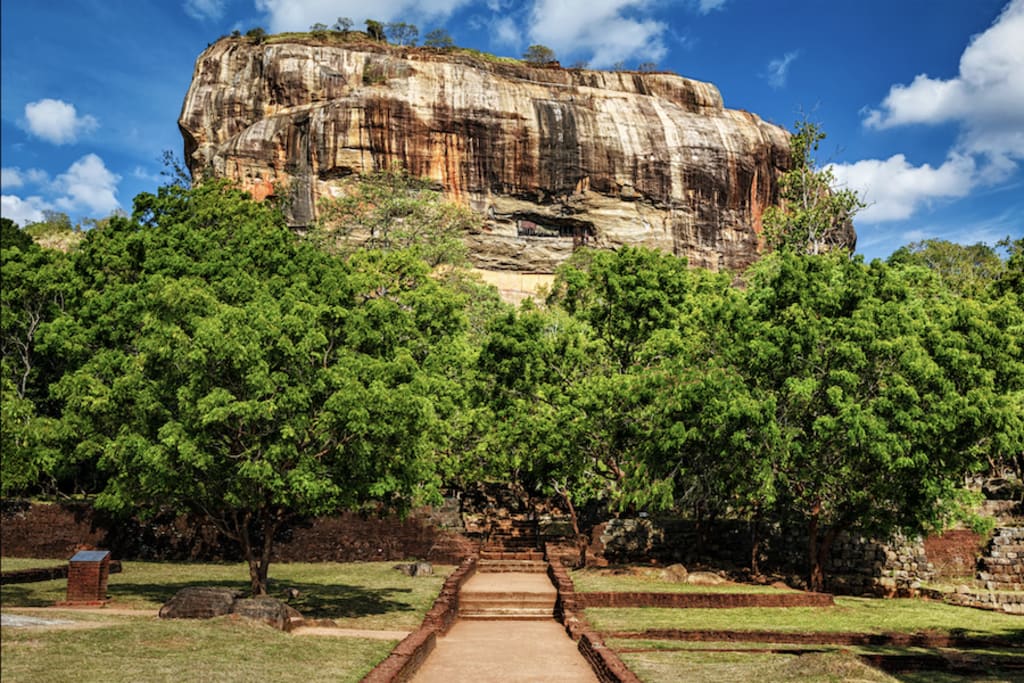The Majestic Rock Fortress of Sri Lanka
Sigiriya

Introduction:
Sigiriya, located in the heart of Sri Lanka, stands as an iconic testament to ancient ingenuity and artistic prowess. Often referred to as the "Eighth Wonder of the World," this ancient rock fortress has captured the imagination of historians, archaeologists, and tourists alike. With its rich history, stunning architecture, and breathtaking surroundings, Sigiriya is a cultural gem that offers a glimpse into the advanced civilization that once thrived on the island.
Historical Background:
The history of Sigiriya dates back to the 5th century when King Kasyapa chose this imposing rock as the site for his new capital. According to historical records, King Kasyapa ascended the throne after dethroning his father, King Dhatusena. Fearing retaliation from his half-brother, Mogallana, Kasyapa built Sigiriya not only as a fortress but also as a symbol of power and opulence.
The Architecture of Sigiriya:
What makes Sigiriya truly remarkable is its architectural brilliance, especially considering its age. The rock rises abruptly from the plains, and at its summit, the remnants of a royal palace and a complex network of gardens and reservoirs are still visible. The fortress is renowned for its well-planned layout, intricate water gardens, and advanced hydraulic systems that highlight the engineering skills of the ancient inhabitants.
The Sigiriya Frescoes:
One of the most captivating features of Sigiriya is the collection of frescoes found in a sheltered pocket of the rock. These ancient paintings depict celestial maidens, known as "apsaras," showcasing the artistic talent prevalent during the period. The vibrant colors and meticulous detailing of the frescoes provide a glimpse into the aesthetic sensibilities of the people who once called Sigiriya home.
The Mirror Wall:
As visitors ascend the rock, they encounter the famous Mirror Wall, a highly polished surface that, in ancient times, acted as a reflective backdrop for the king to admire himself as he walked past. Over the centuries, visitors have etched graffiti and inscriptions on the wall, providing a unique historical record and insight into the diverse range of individuals who visited this site.
The Lion's Gate:
Reaching the summit of Sigiriya requires passing through the iconic Lion's Gate, a massive gateway carved in the shape of a lion. Although only the paws and a portion of the lion's head remain today, the gate serves as a powerful symbol of the grandeur and intimidation King Kasyapa sought to project. Climbing through this gate is a thrilling experience that transports visitors back in time to an era of regal splendor.
The Sigiriya Gardens:
Spread across different terraces, the Sigiriya gardens are a testament to the advanced urban planning and horticultural knowledge of the ancient builders. The Water Gardens, Boulder Gardens, and Terraced Gardens showcase a harmonious blend of architecture and nature. The ingenious irrigation systems, including fountains and reservoirs, reflect an understanding of hydraulics that was unparalleled in its time.
The Sigiriya Rock as a Cultural Symbol:
Beyond its architectural and engineering marvels, Sigiriya holds significant cultural and symbolic value for the people of Sri Lanka. The rock fortress is a UNESCO World Heritage Site, and its preservation is a testament to the nation's commitment to safeguarding its rich history. Sigiriya is often depicted in Sri Lankan art, literature, and folklore, further solidifying its place as a cultural icon.
Challenges in Preservation:
Despite its enduring legacy, Sigiriya faces modern challenges related to preservation and tourism. The influx of visitors, while economically beneficial, puts a strain on the delicate ecosystem and archaeological remains. Balancing the need for tourism with the imperative to protect this historical site requires careful planning and sustainable practices to ensure Sigiriya's longevity.
Conclusion:
Sigiriya, with its awe-inspiring architecture, historical significance, and cultural resonance, stands as a testament to the remarkable achievements of ancient Sri Lankan civilization. As visitors explore the rock fortress, they are transported back in time to an era of kings and elaborate gardens, where engineering and artistry melded seamlessly. Sigiriya is not merely a tourist destination; it is a living testament to the ingenuity and creativity of the people who shaped the island's rich history. Preserving and appreciating Sigiriya is not just a responsibility for Sri Lanka but for all those who value and cherish the wonders of our shared human heritage.
About the Creator
Enjoyed the story? Support the Creator.
Subscribe for free to receive all their stories in your feed. You could also pledge your support or give them a one-off tip, letting them know you appreciate their work.





Comments
There are no comments for this story
Be the first to respond and start the conversation.